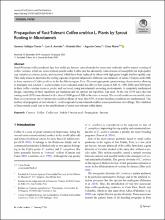Por favor, use este identificador para citar o enlazar este ítem:
https://hdl.handle.net/20.500.12921/434Registro completo de metadatos
| Campo DC | Valor | Lengua/Idioma |
|---|---|---|
| dc.contributor.author | Vallejos Torres, Geomar | - |
| dc.contributor.author | Arévalo López, Luis | - |
| dc.contributor.author | Ríos, Orlando | - |
| dc.contributor.author | Cerna Mendoza, Agustín | - |
| dc.contributor.author | Marín, César | - |
| dc.date.accessioned | 2020-02-13T22:23:31Z | - |
| dc.date.available | 2020-02-13T22:23:31Z | - |
| dc.date.issued | 2020-01 | - |
| dc.identifier.citation | J Soil Sci Plant Nutr (2020) | es_ES |
| dc.identifier.issn | 0718-9516 | - |
| dc.identifier.uri | https://hdl.handle.net/20.500.12921/434 | - |
| dc.description.abstract | Small Peruvian coffee producers face low yields per hectare, caused mainly by recent rust outbreaks and by natural crossing of coffee varieties, which are sown without specific order. Coffee rust has drastically reduced areas of susceptible but high-quality cup varieties as caturra, pache, and nacional, which have been replaced by others with high grain weight, but low-quality cup. This study aimed to determine the rooting capacity of sprouts subjected to different concentrations of indole-3-butyric acid (AIB) in three varieties of Coffea arabica, in the San Martín region, Peru. The most appropriate sprout rooting characteristics allowing to propagate rust-tolerant C. arabica plants were evaluated, under the effect of four doses of AIB (0, 1000, 2000, and 3000 ppm) in three coffee varieties (caturra, pache, and nacional), using microtunnels as rooting environments. A completely randomized design, consisting of three repetitions per treatment and six sprouts per repetition, was used. At the end of 50 days, the best rooting result (89%) was obtained with a dose of 2000 ppm of AIB in the caturra variety. The overall results are successful, since there is a conversion rate of sprouts into useful seedlings of more than 85%, if proper handling conditions are implemented. This method of propagation of rust-tolerant C. arabica sprouts by microtunnels enables a mass production of seedlings. The validation of these results could lead to the establishment of entire rust-tolerant coffee farms. | es_ES |
| dc.format | application/pdf | es_ES |
| dc.language.iso | eng | es_ES |
| dc.publisher | Springer | es_ES |
| dc.relation | info:eu-repo/semantics/article | es_ES |
| dc.relation.uri | https://link.springer.com/article/10.1007/s42729-020-00180-7 | es_ES |
| dc.rights | info:eu-repo/semantics/closedAccess | es_ES |
| dc.rights.uri | © 2019 Springer Nature | es_ES |
| dc.source | Instituto de Investigaciones de la Amazonía Peruana | es_ES |
| dc.source | Repositorio Institucional - IIAP | es_ES |
| dc.subject | Coffea arabica | es_ES |
| dc.subject | Hemileia vastatrix | es_ES |
| dc.subject | Roya | es_ES |
| dc.subject | Enfermedades fungosas | es_ES |
| dc.subject | Enraizamiento | es_ES |
| dc.subject | Propagación vegetativa | es_ES |
| dc.subject | Brotes | es_ES |
| dc.subject | Riego subterráneo | es_ES |
| dc.subject | AIB | es_ES |
| dc.subject | San Martín | es_ES |
| dc.subject | Amazonía | es_ES |
| dc.title | Propagation of rust-tolerant Coffea arabica L. plants by sprout rooting in microtunnels | es_ES |
| dc.type | info:eu-repo/semantics/article | es_ES |
| dc.identifier.journal | Journal of Soil Science and Plant Nutrition | es_ES |
| dc.description.peer-review | Revisión por pares. | es_ES |
| dc.identifier.doi | https://doi.org/10.1007/s42729-020-00180-7 | es_ES |
| Aparece en las colecciones: | Artículos en revistas indexadas | |
Ficheros en este ítem:
| Fichero | Descripción | Tamaño | Formato | |
|---|---|---|---|---|
| Vallejos_articulo_2020.pdf Until 2040-01-01 | Texto Completo | 616,81 kB | Adobe PDF |  Visualizar/Abrir Request a copy |
Compartir :
Los ítems de DSpace están protegidos por copyright, con todos los derechos reservados, a menos que se indique lo contrario.



